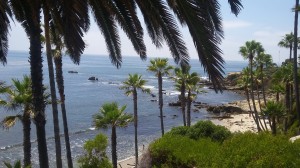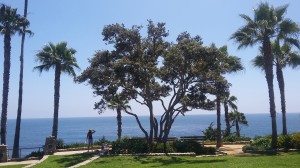THE GAZEBO AT LAGUNA BEACH
THE GAZEBO AT LAGUNA BEACH
By
Charles N. Stevens
Photos by Dolores Seidman
One of the most attractive places in the United States is only an hour away by car from Monterey Park. It’s Laguna Beach, a favorite of tourists from both here and abroad. A stroll on its extensive pathway along the bluffs, all in a park setting, is truly unforgettable. Waves crash against the rocks below and sweep onto the sandy beaches. In this article, I’ll describe what I saw and heard from a single spot, Laguna’s famous gazebo.
Perched at a perfect place where a bluff juts out along the cliffs at Laguna Beach, is a sturdy gazebo. From it I can survey the beaches, rocks and sea as well as the distant curve of the coastline now wrapped in light haze. Not only is it a favorite spot for tourists but it is also a popular scene for weddings.
Today I’m standing in the shaded gazebo, leaning on its wooden railing and looking out at all I can see. Just offshore is a large rock that resembles a petrified whale lurching out of the sea, swells beating against it. So permanent is it that, that seabirds seek its refuge for rest. Most of the birds are dark cormorants that not only relax but spread their wings to dry them out. They tolerate a few pelicans in their midst. The smoother part of the rock where the birds nap is covered with dazzling white guano that has accumulated over the years, or centuries. The black bodies of the birds contrast sharply with the brilliant whiter-than-snow they stand upon. The formation is aptly called Bird Rock.
I listen to the talk of tourists, their babble blending with the soft thunder of breaking waves and the subtle sound of the cool sea wind in my ears.
I look down on the sand beach bordered with large angular rocks, waves pounding against them, spray flying. A woman stands in a pool that fills and empties with the rhythm of the surf. Her husband stands on the sand near her, a baby snugged in a carrier on his chest, camera poised in the direction of his wife. She playfully poses and kicks the water with her right foot. I know it’ll be a great picture with rocks and breaking waves in the background. I admired them as a young happy family which always pleases me.
Near me in the gazebo is a young Asian woman, I think Japanese, who is speaking in her language to her video camera, quickly describing (I assume) where she is and what she’s seeing. I know that the Japanese people like to document where they have been.
Down on the beach a young woman carrying a camera with a foot-long scope, looks for a place to take a perfect photo. At the surf line, a monstrous rock, the mass tilted on its side, reveals the ancient strata that formed it. The eroded strata form stairsteps of a sort that tempt people to climb to its top. A mother holds the hands with two tiny girls as all three slowly scale the rock. With each step their small feet touch another point in geologic time. Reaching the highest point, they carefully turn and pose for the inevitable photo. I’m struck by the youth and tenderness of the climbers contrasted with the ruggedness of the ancient rock.
Seagulls sail past the gazebo, their wings steady, riding the currents flowing over the cliffs. I watch the birds’ shadows on the white sand below the bluff, even more interesting than the birds themselves. My shoes slide on the gritty brick floor of the gazebo, sand tracked in by the beach goers. Lovers and individuals have carved their initials on the wooden rails which makes me wonder why.
A woman wearing white slacks with a striped top enters the gazebo, remaining for a long time, enjoying the view. A young woman with long curly hair walks in and stands near her. The woman in slacks says to her, “I’ve been in the gazebo to look at the view hundreds of times, but every time seems like the first time. I love it so much.” The young woman says, “Oh yes. it’s just like Hawaii.” In contrast, two other women hurry into the gazebo talking to each other. They take quick glance then walk out, still talking. It is as though they had seen nothing.
Down below on the beach, a young Asian woman spells her name, CINDY, in large block letters in the sand. Standing by her name, she jumps straight up, throwing her arms out and her head back. She performs the “dance” several times as someone I can’t see photographs or videos her. I can imagine the photo, her name in the sand, her artistic leaping, waves washing against the rocks behind her. I’m intrigued by her performance, considering it a work of art.
Offshore, a sailboat thrusts its white triangle into the blue of the sky. The boat and the deep indigo of the sea reminds me of a painting by Edward Hopper hanging in the American section of the Huntington Library Art Gallery. Nearby, a fishing boat churns up the water leaving a trail of white foam.
I leave the gazebo and slip my little notebook with all its scrawls into my back pocket.
Of course, Laguna Beach is much more than I described in my piece. The village with its many quaint shops, galleries and restaurants is a great attraction. So is the wide beach, including its basketball courts. It is home to the famous Sawdust Festival and the Pageant of the Masters. It is easy to get around in Laguna Beach as the city provides free and frequent trolley buses to most any spot during the summer months.

This is the essence of Laguna Beach: Palms, ocean, beaches and breaking waves.

The ocean is always in view on the walk along the bluff.

On the bluff walk we found this melaleuca tree that can't decide which way it wants to grow.
MONTEREY PARK AUTHOR PUBLISHES 4th BOOK – Seeking More of the Sky: Growing Up in the 1930’s:
Charles “Norm” Stevens, a 43 year resident of Monterey Park has recently published his 4th book: Seeking More of the Sky: Growing Up in the 1930’s. This is the story of a young boy growing up in Inglewood, California in the l930’s. This was a time during the depression when unemployment was affecting many and the banks were closed, while the clouds of war were gathering in Europe. But he was lucky enough to be raised in a loving family, the power of that love reflected throughout his stories.
Stevens is the author of three previous books about his experiences during WWII:
An Innocent at Polebrook: A Memoir of an 8th Air Force Bombardier (Story of his 34 bombing missions from his base at Polebrook, England over Germany and France)
The Innocent Cadet: Becoming A World War II Bombardier (A prequel to the first, telling of his training in the U.S. before going overseas into combat.)
Back from Combat: A WWII Bombardier Faces His Military Future from Combat: (This book details the time from when he returned from combat in England until the end of the war.)
He is known to the readers of The Citizen’s Voice as the author of Travel Log Articles including “Cruising the Rhine and Mosel”,” Best of the West”, “In Search of Snow” , “From Paris to Normandy on the Seine”, and “Exploring New York”. He is retired, having taught for 32 years, primarily in the Montebello Unified School District.
Those interested in purchasing an autographed copy of any of his books, may contact the author at 323-721-8230 or Normstevens24@gmail.com.



